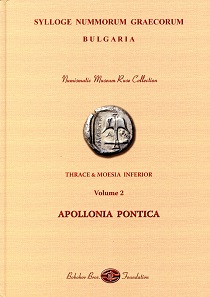by Ursula Kampmann
translated by Almuth Klingner
May 31, 2018 – The second volume of the SNG Bulgaria dedicated to the extensive collection of the Numismatic Museum Ruse, which devotes itself exclusively to the Bobokov collection, Dimitar Draganov has dedicated – as opposed to the traditional sylloges we know – to one single town. Volume 1 about Deultum from the year 2005 is now followed by Volume 2 about Apollonia Pontica.
Dimitar Draganov, SNG Bulgaria. Numismatic Museum Ruse Collection. Thrace & Moesia Inferior. Volume 2: Apollonia Pontica. Bobokov Bros. Foundation, Sofia 2017. 125 p., color illustrations throughout. 21 x 30 cm. Hardcover. ISBN 978-954-9460-06-3. 80 euros.
A total of 550 items of currency from Sozopol, the ancient Apollonia Pontica, are part of the collection of the Bobokov brothers. They range from the bronze arrowheads which were used as payment in the Archaic period to the coins produced under Roman rule. Also important are the coins from two hoards which are compiled again in this catalog. Thus, the extensive Bobokov collection is of vital importance for studying the monetary history of Apollonia Pontica. That said, the new SNG volume is far more than a simple provision of material.
In fact, Dimitar Draganov starts his catalog with a comprehensive commentary: First, the history of the town by the Black Sea is summarized in short, followed by a detailed explanation of the means of payment in Apollonia Pontica. The author structures the monetary history and discusses it in simple, well-put words. In doing so, he condenses research findings from numerous separate studies and provides access to the many specific examinations on this topic written in Bulgarian for those of us who speak mostly English.
Especially useful is the concluding chronology offered by Draganov for the different eras of Apollonia Pontica’s monetary history.
What follows is the catalog itself, providing enough material to find a die-identical specimen for most of Apollonia Pontica’s coins. After the scientific discussion in the introduction, the catalog is kept rather simple. As has been established for the SNGs of Greek coinage, the text is found on the left, the image on the right. The text includes the general information: number, material, denomination, diameter, weight, die axis and the question whether there has been an overstrike, which is the case for many of these coins. Citations are provided not for individual dies, but rather for the respective mint marks or officials. Occasionally, information on the provenance is added.
Indices conclude this highly useful book, which is sure to quickly enter numismatic libraries as the new, easy-to-use standard reference for the coins of Apollonia Pontica.
The book’s thought-through structure is especially charming, as it provides the readers with what they want and need to know in only a few words. Nowadays, with even scientists boasting that they do not have the time to read an entire book and only pick out what they need for their studies (yes, I have in fact heard such things multiple times over the last few years!), we appreciate an author who is not infatuated with his own verbosity, but rather keeps his words factual and short.
Only one thing is left to say: We are already looking forward to the next SNG volume about the Numismatic Museum Ruse Collection!
You can order the new SNG volume about Apollonia Pontica at Paul-Francis Jacquier in Kehl / Germany or at the author.





